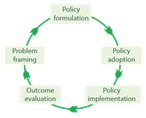![]() Usefulness
Usefulness
This brief can be used to understand the stages of the policy cycle and how different types of biodiversity arguments can be used at each stage.
Transferability
The policy cycle model is general and thus not specific to biodiversity-related policies. The 13 BESAFE case studies have brought more detailed and contextual knowledge on cyclic and iterative biodiversity policy processes.
The policy cycle
The policy cycle model considers the policy process as an iterative, ongoing cycle of policy design, negotiation, development, implementation and evaluation. BESAFE divides the policy cycle into five phases: 1) Problem framing, where the issues that the policy needs to address are identified; 2) Policy formulation, where policy options are developed; 3) Policy adoption, where a particular course of action is adopted; 4) Policy implementation where policies are put into effect; 5) Policy evaluation where results are monitored, and problems and solutions reconsidered (Fig. 1).

Different types of arguments at different stages
Policies are constantly reformulated as the different stages inform and shape each other, and arguments play an important role at each stage. Analysis of the 13 BESAFE case studies shows how different types of arguments can be used at different stages of the policy cycle. There are a number of possible reasons for this:
- ‘Trial and error’, as stronger arguments persist and weaker ones disappear;
- Historical evolution of arguments over time, e.g. the rise of ecosystem service arguments;
- Deliberate targeting of arguments to different audiences at different stages of the policy cycle;
- Better targeting of arguments as more information on specific stakeholder needs emerges during the policy-making process.
- Judging by the frequency of different types of arguments at each stage, it appears that arguments based on the intrinsic value of nature often dominate at the early stages of the process, while arguments based on social and economic benefits are used more in the middle of the process. Legal obligation arguments are most frequent at the implementation and evaluation stages.
- A case study on urban development in Finland shows that the ecosystem service concept and integrated conservation and development arguments may be overridden by segregated biodiversity protection and urban development arguments, as well as specific ecosystem services arguments.
- Case studies in areas with high pressure on land use showed that recreation arguments partly replace inherent value arguments but are still used in favour of conservation.
- In areas where there was a specific conflict over land use, legal arguments tend to replace more rounded inherent value and balance of nature arguments where a concrete conflict of the area use is at stake.
Lessons learned
- Arguments tend to evolve over the course of the policy cycle, and different arguments may become effective at different stages. As better information on stakeholders and their needs emerges, it can be beneficial to replace or supplement broad, general arguments, such as the need to maintain essential ecosystem services, with more precise arguments that focus on the benefits of particular services to specific stakeholders.
- Similarly, arguments that treat biodiversity in isolation from society, such as those based on the intrinsic value of nature or on the scientific evidence for declining biodiversity, can be replaced by arguments that people personally relate to.
Looking for more information on effective arguments for biodiversity?
For more BESAFE results, including separate briefs focusing on other case studies and various aspects of argumentation, see http://www.besafe.pensoft.net [ref BESAFE toolkit].
This brief is a result of research carried out under the BESAFE project. This brief was written by Eeva Primmer, Pekka Jokinen and Malgorzata Blicharska.
Reference: Primmer, E., Jokinen, P., Blicharska, M. 2014. Final report synthesizing the analysis on effectiveness in case studies. Biodiversity and Ecosystem Services: Arguments for our future Environment (BESAFE). Deliverable No: 2.3.
The BESAFE project is an interdisciplinary research project funded under the European Community’s Seventh Framework Programme, contract number: 282743.
http://www.besafe.pensoft.net/ pekka.t.jokinen@uta.fi
